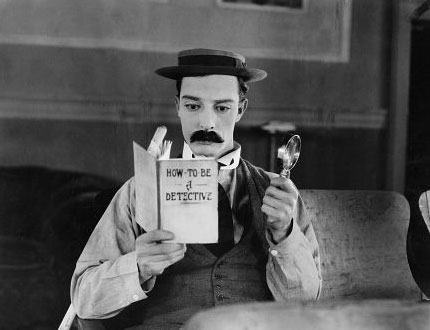
Sherlock, Jr. (1924)
Cast: Buster Keaton, Kathryn McGuire, Joe Keaton, Erwin Connelly, Ward Crane
Director: Buster Keaton
Writers: Clyde Bruckman, Jean C. Havez
BW-45 minutes
For silent film aficionados Charlie Chaplin is the ne plus ultra of comedians. Certainly Chaplin had a wide emotional range which he was able to exploit at every turn; with him, slapstick humor and pathos—if not bathos—could be only a few frames apart. There is no denying Charlie Chaplin’s talent.
For this silent film enthusiast, however, Buster Keaton is still my favorite comedian of the era. No knock against Chaplin, but there is something irreducibly American about Keaton, especially in his boundless enthusiasm and unquenchable energy in accomplishing his goals. If a situation seemed hopeless, Keaton would simply redouble his efforts and win out in the end—no defeatism for Buster. For him, the most intractable problems would always involve women in some way—and thus has it ever been with men.
Buster Keaton didn’t have that wide emotional range that Chaplin possessed, but he didn’t really need it. In fact, he eschewed facial emotions, leading to his nickname "The Great Stone Face." Keeping a dead pan regardless of the situation, Buster was still able to convey exactly what he should be feeling at any given moment. Now that’s talent!
Sherlock, Jr. is one of Keaton’s best efforts. In it he plays a film projector operator whose dreams mirror his real-life anxieties, so you shouldn’t think that the movie is simply a shallow comedy. As Dan Callahan writes:
"With Sherlock, Jr., he [Keaton] came up with a haunting little meditation on movies and dreams. Projectionist Buster falls asleep at the controls and dreams that he can enter the film he is unreeling. With a series of ingenious visual effects, Keaton gives us a perfect demonstration of what it would be like to climb up onto a screen and become a part of the movie we are watching. It’s an unforgettable scene. Without self-consciousness, Keaton brings home the wondrousness of the medium itself, submerging himself in the ocean of its superb and liquid unreality. When he steps onto the screen, he fulfills something in all of us."
It is within this framework of fantasy that Buster acts out some of his most inventive visual gags—falling in and out of the dream world of the film-within-a-film, pretending to be the suave supersleuth (more like James Bond, in fact) who nearly gets it from an explosive billiard ball, diving through a window in a tuxedo and coming up from the ground inside a woman’s dress, diving headfirst yet again through—yes, through—another human being, an exquisitely-timed descent hanging from a railroad crossing gate into a moving car (if you can, run that sequence in slow motion), a gag involving Buster all alone on a bicycle’s handle bars approaching a train that’s just about to pass a trestle, and another stunt in which he falls from a moving train (and during which, he learned years later, he actually broke his neck). It seems that one of Buster’s favorite gag props was trains; he also used them to good effect in The General .
Buster Keaton was a comic film genius, no two ways about it.
You can find a detailed description of Sherlock, Jr. here.
Next time: Buster in The Twilight Zone.
—Mike Gray

I fully agree with you both on Chaplin. I have never liked him at all, for just the reasons you cite.
Lars, your description of Chaplin as “mean” is spot-on, and you are quite correct to see his films as conveying a visual Marxism, as you so cleverly put it. Instead of working hard to overcome his shortcomings and achieve his goals–as Keaton and Harold Lloyd’s characters did (and Keaton was quite physically small himself, hardly any taller than Chaplin if at all)–Chaplin hates those who have what he wants.
That is why Chaplin’s character is a tramp.
Lars:
“visual Marxism”—You may have coined a term that, given today’s political climate, might be increasingly useful as time “progresses.”
And I agree with everything you say about Chaplin’s mean little tramp.
Buster was always trying to do the right thing. Many of his stories involved the crazy complications that resulted when his intentions were misunderstood, either through circumstance or because the villain(s) somehow subverted them.
Judging from what I’ve seen on TV and in the movies, situations with people working at cross purposes have long been a staple of comedy.
Oh yes. Oh yes, absolutely. Keaton may have been the greatest film comedian of all time, if anybody wants my opinion.
I never liked Chaplin because, when you got down to it, his little tramp was mean. He played nasty tricks on people who’d done nothing to deserve them, and we were supposed to laugh because Chaplin was little and his victims were big. It was visual Marxism, and it always rubbed me the wrong way.
Keaton was a good guy. He meant well, and he did his best with what he had, and he never said die. He never played on our pity, either, as Chaplin did. And his incredible athleticism and timing produced results you’d have a hard time getting today with all the CGI in the world.